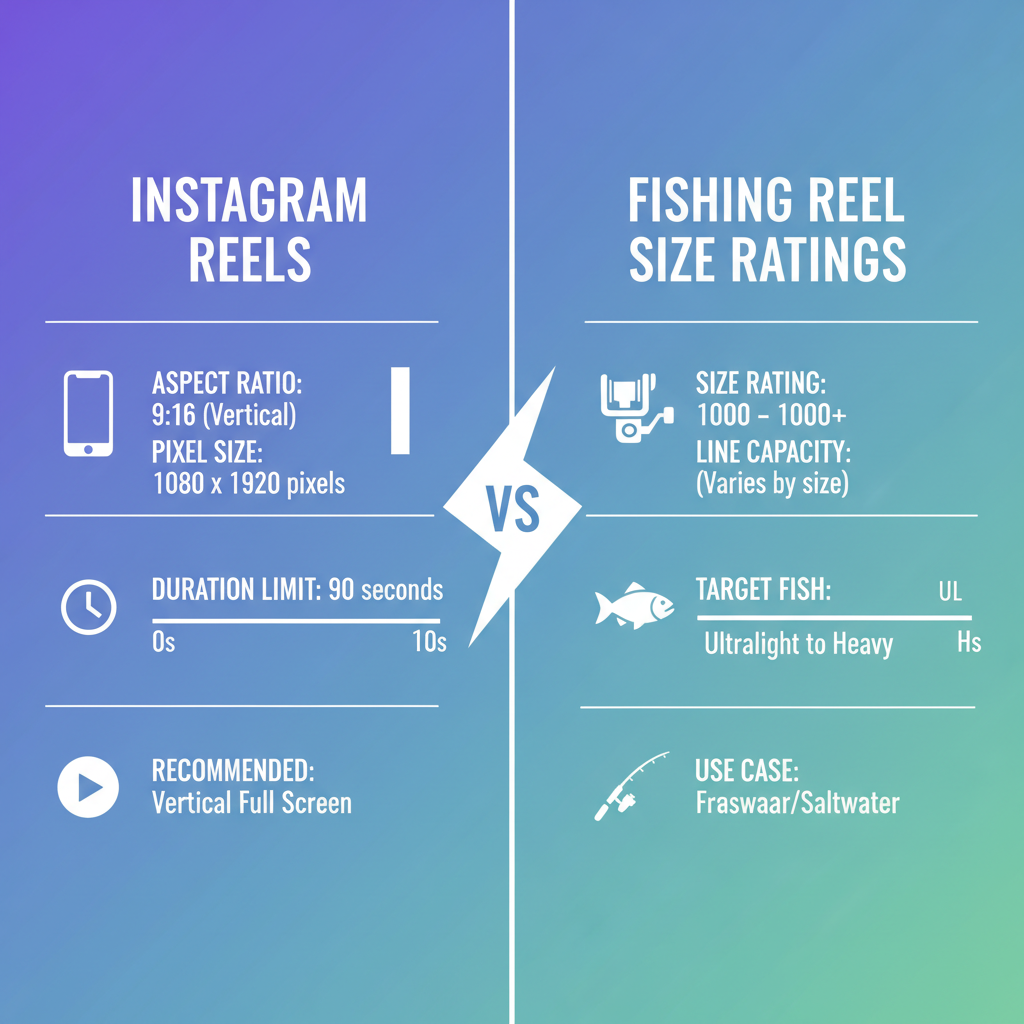What Size Is a Reel Explained for Instagram, Fishing, and Fi
Learn how reel size varies for Instagram videos, fishing gear, and film reels, and how choosing the right dimensions impacts quality and performance.

Understanding "What Size Is a Reel" Across Different Contexts
The phrase what size is a reel can mean very different things depending on whether you are talking about Instagram videos, fishing gear, or film projection. In each case, reel size directly affects quality, performance, and usability. Choosing the correct size helps ensure smooth playback for digital content, optimal catch rates for anglers, and proper storage for filmmakers.
This guide explores reel sizing across Instagram, fishing, and film, so you can make knowledgeable decisions no matter the medium.

---
Why Reel Size Matters
Although the word reel is shared among these domains, its sizing principles vary greatly:
- Instagram Reels: Size impacts video quality, layout, and engagement.
- Fishing reels: Physical spool size influences casting distance, line capacity, and targeted species.
- Film reels: Diameter restricts how much footage can be stored and projected at once.
Selecting the correct reel size ensures optimal performance and presentation across contexts.
---
Instagram Reels: Digital Dimensions and Duration
An Instagram Reel is a short-form video designed for mobile consumption. Each reel must comply with platform specifications.
Duration Limits
- Up to 90 seconds (as of 2024 updates)
- Multiple clips can be stitched into a single reel
Aspect Ratios & Pixel Dimensions
- Recommended aspect ratio: 9:16 (vertical orientation)
- Minimum resolution: 720 x 1280 pixels
- Best practice resolution: 1080 x 1920 pixels for sharp and professional-looking visuals
Importance of Reel Size in Instagram
If your video’s resolution or aspect ratio does not match platform requirements, it could be cropped or displayed with poor quality. Proper sizing ensures your reels are attractive and engaging.

---
Fishing Reels: Sizing Conventions
In angling, reel size refers to both model number and spool capacity.
Common Size Ratings
Manufacturers list reel sizes with numbers such as 1000, 2500, 4000, 5000+. While there is no exact industry standard, general patterns include:
- 1000–2500: Light freshwater, targeting small species
- 3000–4000: Medium freshwater or light saltwater applications
- 5000+: Heavy saltwater fishing for large, strong species
Factors That Depend on Reel Size
- Line Capacity: Amount of fishing line the reel can hold (measured in yards/meters at a specific test strength)
- Drag System Strength: Bigger reels usually have stronger drag systems
- Casting Range: Larger spools can release more line per cast, aiding longer distances
---
Film Reels: Physical Sizes and Footage Capacity
Before the digital era, physical film reels stored and projected movies and educational videos.
Standard Film Reel Diameters
- 7-inch reels — Short films or segments
- 10.5-inch reels — Educational/instructional films
- 14-inch reels — Standard feature-length storage
- 16–20-inch reels — Large-scale cinema projection
How Diameter Affects Footage Length
The footage capacity depends on both reel diameter and film gauge.
For example, a 14-inch reel of 35mm film generally holds about 1,000 feet — which equals roughly 10 minutes of footage at 24 frames per second.
---
Comparison of Reel Sizes Across Contexts
| Context | Size Metric | Common Values | Implication of Size |
|---|---|---|---|
| Video duration & pixels | 15–90 sec, 1080x1920 | Determines viewability and quality | |
| Fishing | Model number & spool capacity | 1000, 2500, 4000, 5000+ | Impacts target species & casting |
| Film | Physical diameter | 7", 14", 20" | Limits film length and storage |
---
Tips for Choosing the Right Reel Size
For Instagram
- Record at 1080x1920 to perfectly fit standard mobile screens
- Keep content under 90 seconds for maximum retention
- Plan framing for vertical display
For Fishing
- Match reel size to your target species and line type
- Keep in mind that larger reels are heavier and may cause fatigue
- Select a drag system that can handle the weight and fight of your intended catch
For Film
- Choose reel diameters that match your projector or archival system
- Avoid overloading reels to prevent film warping
- Label by reel size and footage length for efficient editing
---
Common Mistakes When Selecting Reel Size
- Ignoring Format Requirements
- Using horizontal videos for Instagram Reels can hurt engagement.
- Over- or Undersizing Fishing Gear
- Choosing a 1000 reel for saltwater species can lead to failure; a 5000 reel for small trout is unnecessarily bulky.
- Mismatching Film Reel to Projector
- Some projectors cannot handle large reels — always check compatibility.
---
Best Practices for Reel Selection

- Stay updated on platform specs for social media posting
- Test your fishing reel for comfort and casting before major trips
- Organize film reels by diameter and footage for easier handling
---
Quick Reference Chart
| Domain | Recommended Size for Beginners | Notes |
|---|---|---|
| 1080x1920, 30–60 sec | Balances quality with viewer attention | |
| Fishing | 2500–3000 | Versatile for many freshwater species |
| Film | 10.5-inch | Ideal for shorter educational content |
---
Conclusion
Understanding what size is a reel requires knowing the conventions and requirements of the specific context.
On Instagram, size determines resolution and duration; in fishing, it influences line capacity, drag, and casting comfort; and in film, it sets physical limits on footage length and projection systems.
By exploring these specifications and avoiding common errors, you can achieve the best results — whether your reel plays on a smartphone screen, hauls in your prize catch, or runs smoothly through a projector.
Take action now: Determine your platform or application, review size guidelines, and choose the reel that delivers optimal performance and enjoyment.




